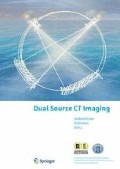Abstract
Recent technical developments in multislice computed tomography (CT) have opened new perspectives in the non-invasive investigation of supra-aortic extracranial and intracranial vessels. Simultaneous acquisition of 64 slices at 0.33 seconds rotation times has made long scan ranges at high spatial resolution feasible. With the introduction of Dual Source CT in 2006, in which two tubes and detectors are mounted orthogonally, it is now possible to acquire one axial image by a gantry rotation of 90° instead the 180° needed in single-source scanners. This cuts acquisition time by half, which is an important factor especially in cardiac imaging. It is also possible to run the two tubes at different voltages — the so-called spiral dual energy CT mode (e.g. 140 and 80 kV) — in order to obtain different attenuations for material decomposition. Multiple dual-energy applications are currently under evaluation: material differentiation, bone removal, iodine quantification, perfusion mapping and plaque imaging to name a few.1–6
Access this chapter
Tax calculation will be finalised at checkout
Purchases are for personal use only
Preview
Unable to display preview. Download preview PDF.
References
Johnson TRC, Krauß B, Sedlmair M, Grasruck M, Bruder H, Morhard D, Fink C, Weckbach S, Lenhard M, Schmidt B, Flohr T, Reiser MF, Becker CR. (2007) Material differentiation by dual energy CT: initial experience. Eur Radiol 17(6):1510–1517
Farkas J, Xavier A, Prestigiacomo CJ (2004) Advanced imaging application for acute ischemic stroke. Emergency radiology 11:77–82
Tomandl BF, Hammen T, Klotz E, Ditt H, Stemper B, Lell M (2006) Bone-subtraction CT angiography for the evaluation of intracranial aneurysms. Ajnr 27:55–59
Zhang Z, Berg M, Ikonen A, Kononen M, Kalviainen R, Manninen H, Vanninen R (2005) Carotid stenosis degree in CT angiography: assessment based on luminal area versus luminal diameter measurements. Eur Radiol 15:2359–2365
Hollingworth W, Nathens AB, Kanne JP, Crandall ML, Crummy TA, Hallam DK, Wang MC, Jarvik JG (2003) The diagnostic accuracy of computed tomography angiography for traumatic or atherosclerotic lesions of the carotid and vertebral arteries: a systematic review. European journal
Lell MM, Anders K, Uder M, Klotz E, Ditt H, Vega-Higuera F, Boskamp T, Bautz WA, Tomandl BF (2006) New Techniques in CT Angiography. Radiographics 26Suppl 1:S45–S62
Author information
Authors and Affiliations
Editor information
Rights and permissions
Copyright information
© 2008 Springer Medizin Verlag Heidelberg
About this chapter
Cite this chapter
Morhard, D., Johnson, T.R.C., Becker, C.R. (2008). Dual Energy: CTA of Head and Neck. In: Seidensticker, P.R., Hofmann, L.K. (eds) Dual Source CT Imaging. Springer, Berlin, Heidelberg. https://doi.org/10.1007/978-3-540-77602-4_18
Download citation
DOI: https://doi.org/10.1007/978-3-540-77602-4_18
Publisher Name: Springer, Berlin, Heidelberg
Print ISBN: 978-3-540-77601-7
Online ISBN: 978-3-540-77602-4
eBook Packages: MedicineMedicine (R0)

